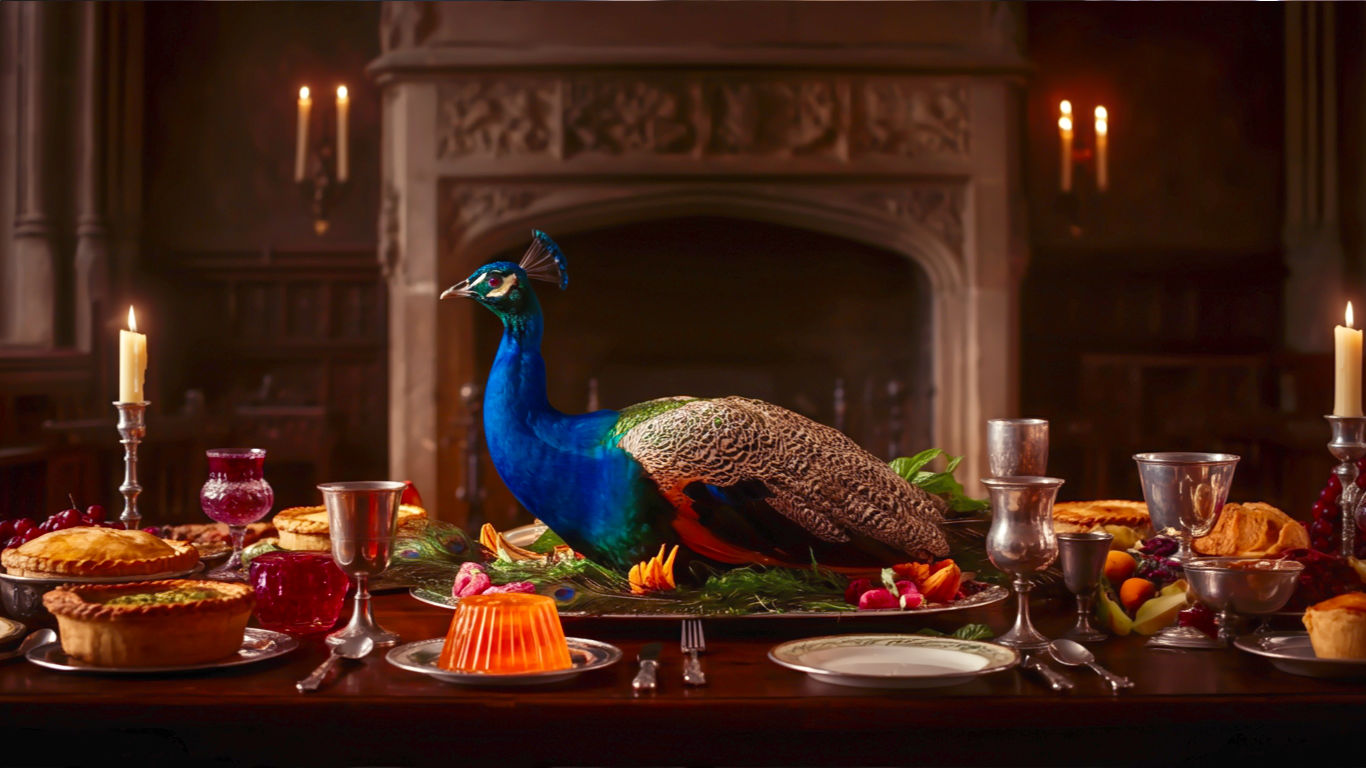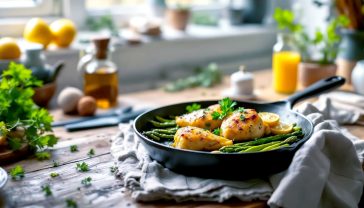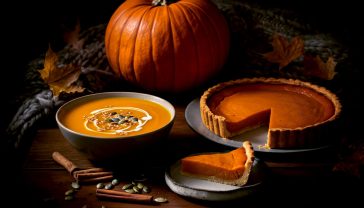A Tudor Feast Fit for a King: Unearthing the Lost Flavours of Britain
Forget bland, boiled history. Tudor food was a vibrant, spicy, and spectacular world of roasted peacocks, sugar sculptures, and rich meat pies. Dive into the lost cuisine of Britain.

This post may contain affiliate links. If you make a purchase through these links, we may earn a commission at no additional cost to you.
Picture this: you’re at Hampton Court Palace. It’s 1540. King Henry VIII, a man whose appetite was as big as his reputation, is about to sit down for dinner. Forget everything you think you know about bland, boiled British food. The air is thick with the scent of woodsmoke, roasting meat, and a heady mix of spices that have travelled halfway across the world.
Before the King is a parade of dishes that would make your jaw drop. A whole roasted peacock, its feathers carefully put back on to look alive. A giant pie filled with live birds that fly out when it’s cut. And intricate sugar sculptures—castles, dragons, and knights—so detailed they look like they belong in a museum, not on a dinner table.
This wasn’t just a meal; it was theatre. It was a spectacular display of power, wealth, and artistry. Tudor food, far from being the stodgy fare we might imagine, was vibrant, surprising, and packed with flavour. It was a world where the rich ate swans and the poor made do with pottage, where sugar was worth more than gold, and where your dinner could be both a feast for the stomach and the eyes.
So, grab a tankard of ale and pull up a stool. We’re about to take a journey back in time to rediscover the lost world of Tudor cuisine. We’ll explore the ingredients, the cooking techniques, and the incredible feasts that defined an era, and we’ll even find out how you can bring a taste of the Tudor times into your own kitchen. It’s a story that’s more exciting, and a lot spicier, than you might think.
A Tale of Two Tables: The Great Divide in the Tudor Diet
In Tudor England, you were what you ate. Your daily meals told everyone exactly where you stood in the world. For the vast majority of the population, food was about survival. But for the tiny, wealthy elite, it was a whole different story.
The Diet of the Rich: A Show of Wealth and Power
If you were a Tudor lord or lady, your dinner table was your stage. Every meal was an opportunity to show off just how rich and important you were.
Meat, Meat, and More Meat: The Tudors believed that meat was a food of power. The wealthy ate staggering quantities of it. A typical feast might feature dozens of courses, with a huge variety of meats. Venison, wild boar, and rabbit were popular, as were domesticated animals like beef, pork, and mutton.
But it was the birds that really stole the show. Forget chicken. The Tudor aristocracy feasted on swan, peacock, heron, and even crane. These weren’t just for eating; they were status symbols. A roasted peacock, re-dressed in its spectacular feathers, was the ultimate centrepiece. It told every guest that the host was fabulously wealthy and had the connections to hunt such prestigious game.
A World of Spice: Today, we can pop to the supermarket for a pinch of nutmeg. In Tudor times, spices were incredibly expensive luxuries. They were imported from Asia and the Middle East along dangerous trade routes, making them worth their weight in gold. Kitchens in great houses were packed with cinnamon, cloves, mace, ginger, pepper, and saffron.
These spices weren’t used subtly. Tudor chefs loved bold, powerful flavours. They would combine sweet and savoury in ways that might seem strange to us now, seasoning meat dishes with fruit, sugar, and a lorry-load of spices. This wasn’t just about taste; it was another way to flash the cash. Using a lot of expensive spices proved you could afford it.
The Sweet Seduction of Sugar: If spices were a status symbol, sugar was the ultimate bling. Known as “white gold,” it was imported in small quantities and cost a fortune. The Tudors had a massive sweet tooth, and the rich used sugar in everything. They didn’t just have it in desserts; they sprinkled it over meat, fish, and vegetables.
The most spectacular use of sugar was in “subtleties.” These were intricate, edible sculptures made from sugar paste or marzipan. They were brought out between courses to entertain and amaze guests. A subtlety could be a miniature castle, a scene from mythology, or a political joke. They were pure art, designed to be admired before being smashed and eaten. Having black, decaying teeth was actually a sign of wealth—it meant you could afford sugar!
The Diet of the Poor: The Daily Grind
For the 90% of the population who weren’t rich, life was very different. Their diet was simple, repetitive, and based on whatever they could grow or afford.
The Importance of Bread and Pottage: The cornerstone of the poor person’s diet was bread. But this wasn’t a nice, fluffy white loaf. It was dark, heavy bread made from rye or barley, known as “maslin bread.” It was filling and provided the bulk of their daily calories.
The other staple was pottage. This was a thick, soupy stew that simmered over the fire all day. The base was oats or barley, cooked with whatever vegetables were available—usually onions, leeks, and cabbage. If they were lucky, a bit of bacon or a cheap cut of meat might be added for flavour. Pottage was the Tudor equivalent of a one-pot meal, and for many, it was the only hot meal of the day.
Limited Meat and Veg: Meat was a rare treat for the poor. They might keep a pig, which would be slaughtered in the autumn, or chickens for eggs. But beef and mutton were generally too expensive. Poaching a deer from the local lord’s land was a serious crime, often punishable by death.
The variety of vegetables was also limited. Potatoes hadn’t arrived in Britain yet, and tomatoes were thought to be poisonous. The average person ate a lot of onions, garlic, leeks, cabbage, and kale. They also foraged for wild greens and herbs to add flavour to their pottage.
A Safer Sip: Water in Tudor times was often dirty and dangerous to drink. Instead, everyone—including children—drank “small ale.” This was a weak, low-alcohol beer. The brewing process killed off most of the harmful bacteria, making it a much safer option than water. It was also a source of much-needed calories.
Inside the Tudor Kitchen: Fire, Smoke, and Manpower
The Tudor kitchen was the engine room of the great house. It was a hot, smoky, and incredibly busy place, a world away from our modern, clean kitchens with their electric ovens and fancy gadgets.
The Heart of the House
In a palace like Hampton Court, the kitchens were a massive operation. Henry VIII’s kitchens had to feed a court of over 600 people, twice a day. This required an army of staff and a huge, complex space. The Great Kitchens at Hampton Court were built to impress, with vast fireplaces and high, vaulted ceilings to let the smoke escape.
The layout was designed for efficiency. There were separate departments for different tasks:
- The Main Kitchen: This was where the roasting and boiling happened, dominated by enormous fireplaces.
- The Bakehouse: For baking bread, pies, and pastries in huge, wood-fired ovens.
- The Scullery: For all the washing up.
- The Larder: A cool place for storing meat, fish, and other fresh ingredients.
- The Spice Cupboard: A secure, locked room where the hugely expensive spices were kept.
Cooking with Fire
Tudor chefs had only one source of heat: fire. Mastering it was a real skill. There were two main methods of cooking.
Roasting on the Spit: Roasting was done on a long iron spit in front of a roaring open fire. This was mainly for large joints of meat or whole animals and birds. Turning the spit was a hot, tiring, and boring job, often done by a young boy called a “spit-jack” or “turnspit.” He had to sit by the fire for hours, slowly rotating the spit to ensure the meat cooked evenly. It was crucial to catch the dripping fat, which was collected in a pan and used for cooking or to make candles.
Boiling in the Cauldron: Boiling was done in huge metal cauldrons hung over the fire from a hook and chain. This was how they made pottage, stews, and boiled meats. Managing the heat was tricky; the cook had to raise or lower the cauldron to stop the contents from burning or boiling over.
The Kitchen Brigade
Running a Tudor kitchen required a strict hierarchy, like a mini-army. At the top was the Clerk of the Kitchen, an educated man who managed the budget, ordered supplies, and oversaw the entire operation. He was a powerful figure in the household.
Under him were the master cooks, skilled craftsmen who created the spectacular dishes for the lord’s table. Then came a whole team of specialised staff: yeomen, grooms, and pages, each with specific roles, from butchering meat to making sauces or baking bread. It was a highly organised, professional environment, dedicated to producing food that was as impressive as it was delicious.
A Burst of Flavour: What Tudor Food Really Tasted Like
Forget the idea that food in the past was plain. The Tudor palate was surprisingly complex and adventurous. They loved strong, intense flavours and combinations that might seem odd to us today.
The Sweet and Sour Obsession
One of the defining features of Tudor cuisine was the love of sweet and sour flavours. Chefs would often balance the richness of meat with the sharpness of fruit or vinegar. A sauce for roast pork, for example, might be made with wine, breadcrumbs, spices like ginger and cloves, and a good amount of sugar and vinegar.
This flavour profile came from medieval traditions but was refined during the Tudor era. Verjuice, the sour juice of unripe grapes, was a common ingredient used to add a sharp tang to dishes, much like we use lemon juice today.
A Riot of Spices
As we’ve seen, the rich were obsessed with spices. But they didn’t just use them to show off. Spices were essential for flavour and, they believed, for health. Tudor medicine was based on the idea of the “four humours” (blood, phlegm, yellow bile, and black bile). Every food was thought to have a particular quality (hot, cold, moist, or dry), and it was important to balance these to stay healthy. Spices like ginger and pepper were considered “hot and dry,” and were used to balance “cold and moist” foods like fish.
Saffron was one of the most prized spices. It gave food a beautiful golden colour and a delicate, aromatic flavour. It was used in both sweet and savoury dishes, from meat stews to rich cakes.
Presentation is Everything
For the Tudors, food had to look as good as it tasted. Colour was incredibly important. Chefs used natural ingredients to make dishes vibrant and exciting.
- Yellow: Saffron or egg yolks.
- Red: Sandalwood or alkanet root.
- Green: Parsley or spinach juice.
- Black: Burnt toast crumbs.
They also loved trickery and illusion. A dish called “cockentrice” involved sewing the front half of a piglet onto the back half of a turkey, creating a mythical beast. Pies were often elaborately decorated, and as mentioned, sometimes filled with live animals for a bit of dinner-time entertainment. This was food designed to be a conversation starter, a spectacle that guests would talk about for weeks.
Tudor Tipples: What Was in Their Cups?
In an age before tea and coffee, what did the Tudors drink? The answer depended, once again, on who you were.
Ale and Beer: The Drink of the People
For most people, the drink of choice was ale or beer. The main difference between them was that beer was made with hops, which acted as a preservative and gave it a slightly bitter taste. Hops were introduced to England from the continent in the 15th century and became increasingly popular during the Tudor period.
People drank ale and beer at every meal. “Small ale” was weak and consumed by everyone. “March ale” was a stronger, better-quality brew made in March to last through the year. Every village had its alehouse, which was the centre of social life, and many large households brewed their own.
Wine for the Wealthy
Wine was the drink of the aristocracy and the church. Most of it was imported from Europe, particularly France. Red wines from Gascony (known as claret) and sweet wines from the Mediterranean were very popular.
Wine was expensive, so it was a clear sign of status. It was served at feasts and important occasions. To make it go further, or to improve the taste of a wine that was starting to go off, it was sometimes mixed with honey and spices to create a drink called hypocras.
How to Eat Like a Tudor: A Modern Guide
Reading about Tudor food is one thing, but tasting it is another. While roasting a swan might be off the cards, it’s surprisingly easy to recreate some Tudor flavours in a modern kitchen. Here are a few ideas.
A Simple Tudor-Style Meat Pie
Pies, or “pyes” as the Tudors called them, were a staple. The pastry case, known as a “coffin,” was often very thick and not meant to be eaten. It was simply a container for cooking the filling.
You will need:
- 500g diced pork or chicken
- 1 onion, chopped
- A handful of dried fruit (prunes or dates work well), chopped
- 1/2 tsp ground ginger
- 1/4 tsp ground cloves
- A pinch of saffron (optional)
- 1 tbsp sugar
- 2 tbsp cider vinegar
- A sheet of shortcrust pastry
Method:
- Fry the meat and onion until browned.
- Add the dried fruit, spices, sugar, and vinegar, along with a splash of water.
- Simmer gently for about 30 minutes until the meat is tender.
- Line a pie dish with the pastry, fill it with the meat mixture, and cover with a pastry lid.
- Bake at 180°C (350°F) for 25-30 minutes, until the pastry is golden.
This dish gives you that classic Tudor combination of sweet, sour, and spiced flavours.
Tudor Gingerbread
This isn’t the gingerbread man you know. Tudor gingerbread was a simple, no-bake sweet treat made from breadcrumbs and spices.
You will need:
- 200g fine white breadcrumbs
- 1 tsp ground ginger
- 1/2 tsp ground cinnamon
- 150ml red wine (or grape juice)
- 100g clear honey
Method:
- Mix the breadcrumbs and spices in a bowl.
- Gently heat the wine and honey in a saucepan until the honey has dissolved.
- Pour the warm liquid over the breadcrumbs and mix thoroughly to form a stiff paste.
- Press the mixture into a shallow, lined tin and leave it to set in a cool place for a few hours.
- Once firm, cut it into squares. You can even decorate it with gold leaf for a truly authentic touch!
The Enduring Legacy of the Tudor Table
The world of Tudor cuisine might seem distant and strange, but its influence can still be found in British food today. Our love of a good meat pie, a rich Christmas pudding full of fruit and spice, and even our taste for sweet and savoury combinations like pork with apple sauce all have roots that stretch back to the Tudor era.
The Tudor period was a time of immense change, and this was reflected in its food. The discovery of the New World would soon bring new ingredients like potatoes, tomatoes, and chillies that would transform British cooking forever. But the Tudor kitchen, with its love of showmanship, bold flavours, and hearty feasting, laid the foundations for much of what we eat today. It reminds us that British food has a rich, complex, and surprisingly spicy history. So next time you tuck into a pie or sprinkle some cinnamon on your porridge, give a little nod to the Tudors. You’re tasting a piece of history.
Further Reading
For those keen to explore this fascinating culinary world in more detail, these resources are an excellent starting point:
- Historic Royal Palaces: The official website for Hampton Court Palace offers a wealth of information about Henry VIII’s kitchens and Tudor court life.
- The British Library: Discover digitised medieval and Tudor recipe manuscripts and articles on the history of food.
- The National Archives: Explore original documents from the period, including household accounts that list food purchases.
- The Time Traveller’s Guide to Elizabethan England by Ian Mortimer: A brilliant book that vividly brings the sights, sounds, and smells (and tastes) of the period to life.






